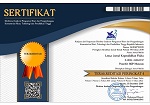PENGEMBANGAN VITUR SEBAGAI MEDIA PEMBELAJARAN FISIKA UNTUK MENINGKATKAN KEMAMPUAN BERFIKIR KREATIF SISWA
DOI:
https://doi.org/10.33394/j-lkf.v3i1.348Keywords:
Vitur, Students’ Creative Thinking Ability.Abstract
This research is purposed to develop caricatur based video as a teching media for physics subjeck to enrich student’ creative thiking ability. The research was developed by using 4 D design which is well know as define, design, develop and disseminate. Collecting data is research. The researcher uses validity of learning intruction test, quistionaire for students, and creative thiking ability test. The research subject of this research is the VIII grade students is the SMPN 5 plampang. The data analysis used in this study is descriptive qualititative approach. The result of vitur validation test shows that using vitur as the physic teaching media to enrich students creative thiking ability can be categorized into “valid†category in which the average score gained by the research subjects is 3,75 and the studen’ responses show the result in average 3,20. This result can be categorized into high category in using vitur as the physic teahing media to enrich student’ creative thiking ability. The creative thiking ability test the was the distributed by researcher to the reseach subjects show the result 67,25%. Ultimately, it can be inffered that vitur as the physics the teaching media is valid and properly used to enrich students’ creative thinking ability.
References
Febrian 2012. pengembangan media audio-visual berbasis kontekstual dalam pembelajaran fisika di SMA
Hobri. 2010. Metodologi Penelitian Pengembangan (Aplikasi Pada Penelitian Pendidikan Matematika). Jember: Pena Salsabila
Jazuli, Akhmad. 2009. Berfikir Kreatif Dalam Kemampuan Komunikasi Matematika. Prosiding ISBN : 978-979-16353-.
Mudani, Y. 2012. Media Pembelajaran. Jakarta: Gaung Persada (GP) press.
Munir. 2013. Multimedia Konsep dan Aplikasi dalam Pendidikan. Bandung: Alfabeta.
Rohani, A. 1997. Media Intruksional Edukatif. Jakarta: PT Rineka Cipta.
Sugiyono, 2013. Metode Penelitian Kombinasi. Bandung: Alfabeta.
Widoyoko, Eko P. 2012. Teknik Penyusunan Instrumen. Yogyakarta: Pustaka Pelajar.
Downloads
Published
How to Cite
Issue
Section
License
Authors who publish with Lensa: Jurnal Kependidikan Fisika agree to the following terms:
- For all articles published in Lensa: Jurnal Kependidikan Fisika, copyright is retained by the authors. Authors give permission to the publisher to announce the work with conditions. When the manuscript is accepted for publication, the authors agree to automatic transfer of the publishing right to the publisher.
- Authors retain copyright and grant the journal right of first publication with the work simultaneously licensed under a Creative Commons Attribution-ShareAlike 4.0 International License that allows others to share the work with an acknowledgment of the work's authorship and initial publication in this journal.
- Authors are able to enter into separate, additional contractual arrangements for the non-exclusive distribution of the journal's published version of the work (e.g., post it to an institutional repository or publish it in a book), with an acknowledgment of its initial publication in this journal.
- Authors are permitted and encouraged to post their work online (e.g., in institutional repositories or on their website) prior to and during the submission process, as it can lead to productive exchanges, as well as earlier and greater citation of published work (See The Effect of Open Access).

This work is licensed under a Creative Commons Attribution-ShareAlike 4.0 International License.



